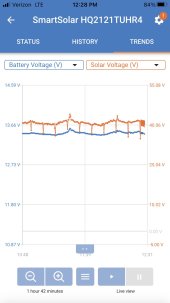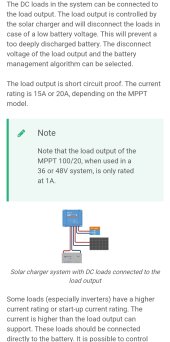I had plans to include a diagram of my setup if/when I start a new thread, but got delayed (again). I’ve had it pencilled on paper
for 5 years, but it needs cleanup before publishing, and a way to point to where I want to upgrade the fusing (the pencilled diagram didn’t note any of the original fusing).
So I'm leaning toward an MRBF fuse at the battery positive, with perhaps a 80 or 100a rating (and 10k AIC from what I’ve read). 6awg wire would go from the MRBF to a secondary circuit breaker or fuse. That 80-100a MRBF ought to protect 6awg (right??). The idea behind the 2nd breaker (or fuse) is the 2nd would be readily accessible, so I don’t have to remove a drawer unit or crawl under the van if only the 2nd one tripped (which should trip first since it is smaller, except in case of battery short circuit). I’m thinking it could be 25a CB185-25 breaker or 30a MAXI or MIDI fuse. From this CB/fuse, the circuit goes to a switch, and then to the Victron. The switch is a NKK S-823D DPDT, rated at 30a @ 48VDC or less (still 15a @ 125vdc I believe).
so, the MRBF’s should protect the 6awg wires, and the smaller CB’s should protect that switch and the Victron…or at least that is my “theory.”
there is more to all this, but let’s start with this. IS THIS (above) A SOUND APPROACH?
OK, here’s where it gets hairier. I have 2 “strings“ of batteries. Gasp!!
So that would mean at least 2 of these MRBF’s (One string is 2x93ah AGM’s in parallel, assuming that would need only 1 MRBF fuse??; the other string is a single 100ah Battleborn LiFePO, which would have its own MRBF fuse). The 2 strings are sufficiently isolated IMHO, though ALL negatives are bonded. That switch I mentioned controls which string (positive) is connected to the Victron. Before anyone goes into convulsions about this 2-string approach, let me point out I’ve had it for 5 years, living in this van for months at a time…just not with Victron, and not with LiFePO until a year ago. It worked fine all summer, but something happened while “parked“ for the winter off-season…which is what brought us to the original point of this thread.
well, one more thing, I believe the 20amp output of the Victron is adequate for my loads, and as Brucey pointed out, the 20a limit appears to apply to both charging and 12v loads…but this is a frequent criticism of my approach. That and the 2-battery-string concept. Maybe if I were starting greenfield, I would ditch the 2-string approach, but it’s saved my bacon more than once, when 1 string became exhausted, or had issues like what caused this thread in the first place. I simply switched the switch, and was back in business, in this case, using the AGM String. I also would have been smart to have bought the Victron 100/30 instead, which has more robust terminals, though lacks the load out connections. But I was getting a bit tapped out ($$$) buying the Battleborn, a bigger 250w solar panel, and the Victron. The older Morningstar (PWM 15a) never hiccup’d, and I used its LVD load outs as well, but I appreciate having more charging and storage juice now. I’m no doubt just plain lucky the cheapo fuse didn’t inappropriately melt before.
 ….WHY? I have no idea).
….WHY? I have no idea). ….WHY? I have no idea).
….WHY? I have no idea).


